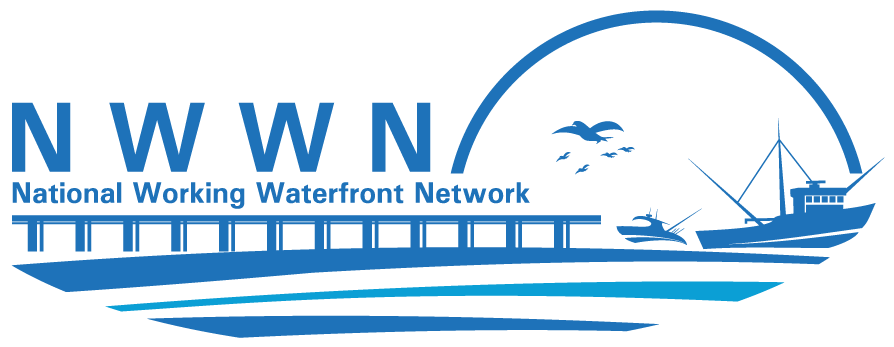
20 Dec Policy Briefing 101: How to Plan a Successful Briefing
Written by the Urban Harbors Institute at UMass Boston
Many of us involved in working waterfront topics recognize the need to engage decision-makers to share information about working waterfront issues like climate change, workforce development, and access. In fact, at the 2022 NWWN conference, Congresswoman Pingree urged attendees to take this on. What many of us don’t necessarily know, however, is how to do that engagement.
In this post, we offer some tips for those of you interested in thinking through what a policy briefing might look like and how to hold one yourself. For the purposes of this post, a policy briefing is an event held to share key information and messages with audiences to help inform decisions.
The content below is based on our experiences pulling together a virtual policy briefing on the Massachusetts Seafood System, which you can watch here. We are not experts by any means. We had a challenge finding guidance as we developed our event, and we learned a lot along the way. If you have the resources to hire someone professionally, it might be a good idea to do so. If, however, you don’t have the funds to bring in external help, here are some tips that might help your event be a success.
(While these steps are presented in numerical order, some of them may happen concurrently, and you may have to revisit steps as the event evolves.)
Step 1: Identify the purpose of your briefing – Is it to provide general information? Raise awareness of a specific concern or opportunity?
Step 2: Form a committee – Think about who can help create a successful event and invite them to join your committee. Consider including content experts, people with connections to your target audience(s), people who have organized briefings, and people who can assist with logistics like how to manage a Zoom webinar or host an in-person event.
Step 3: Determine your audience – Who are you hoping to brief – local, state, and/or federal elected officials? Advocacy organizations? Agency representatives? This will impact timing, format, invitations, and messaging.
Step 4: Develop your key messages – Don’t include so many messages or so much information that your audience is lost or overwhelmed. Remember to use data and stories where you can to help make your points. Include some actions your audience can take if interested, such as supporting a new grant program or participating in a follow-up site visit. For those who cannot advocate due to their position, remember that educating is not the same as advocating and look to find the right way to share your messages.
Step 5: Identify your event format – In-person events and remote events both have advantages and disadvantages. Weigh them in light of factors such as your audience, your budget, and your overall goals. Will people travel to your briefing or will you have better luck if it is branded as a virtual “lunch and learn”? Consider how much time you think you’ll need vs. how much time your audience has. Generally speaking, a 60-90 minute timeframe works well. Be intentional about how information is delivered and who delivers it – the presenter(s) should be credible and knowledgeable. For smooth transitions, identify a moderator or facilitator who can also help keep track of time.
Step 6: Schedule your event – This may seem straight forward, but timing can be critical to the success of your briefing. Be sure to maximize participation by avoiding other events and happenings that might conflict, like the weeks leading up to elections, holidays, and state budgeting deadlines. Think about whether it makes sense to tie your event to another relevant timeframe like seafood month (October) or International Fishermen’s Day (June 29). Be sure to give your committee enough time to plan a good event and provide sufficient notice to potential participants.
Step 7: Send out invitations – Personalized invitations and invitations from trusty-worthy organizations and individuals will help increase your attendance – lean on your committee for help if appropriate. If sending email invites…make sure your invitations go out with enough advance notice to allow people to plan. Check-out resources like Mail Chimp that can help you send out professional-looking invitations, and Eventbrite, that you can use to track registrations if you’re requiring them. Give yourself plenty of time to develop your distribution list – this can take longer than you think. If emailing from an email address instead of a program like Mail Chimp, don’t email a lot of people at once – it’s more likely to go to spam. Avoid sharing all email addresses in the “To” field and instead use the BCC feature. A quick Internet search will yield a whole host of “best practices” for developing and sending email invitations. If your event is through Zoom, make sure the attendees receive the link ahead of time and in a clear manner (i.e., not at the end of a lengthy email). Additionally, it may be helpful to share the link as a calendar invite if possible, so the event is downloaded to the attendee’s calendar.
Step 8: Practice – Before the big day, save yourself some stress and have a run-through to test technology, clarify roles, and make sure that your key messages are coming through loud and clear. Whether in-person or virtual, have your committee meet 10-15 minutes ahead of the briefing to go over logistics and make any last minute adjustments (if necessary).
Step 9: Follow-up – Once your event is over, thank your speaker(s) and committee members. Send a note to those you invited with a quick re-cap, next steps, calls to action, links to resources and the recording, email addresses, etc. Make it easy for them to learn more or find you again when they have questions.

